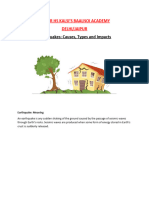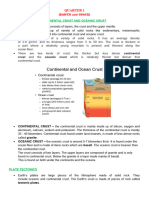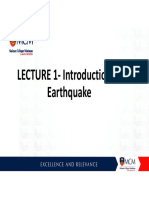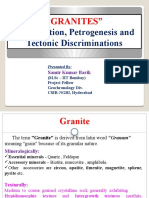SCIENCE
SCIENCE
Uploaded by
FlorentinoCopyright:
Available Formats
SCIENCE
SCIENCE
Uploaded by
FlorentinoCopyright
Available Formats
Share this document
Did you find this document useful?
Is this content inappropriate?
Copyright:
Available Formats
SCIENCE
SCIENCE
Uploaded by
FlorentinoCopyright:
Available Formats
Seismic waves- waves that transmit energy released by an earthquake.
TWO TYPES:
Body waves can travel through the earth's inner layers. Body waves are of a higher frequency than surface waves.
Primary wave (P-wave) is a longitudinal or compressional wave because of the pushing and pulling they do. It travels
fastest in materials, so the P-wave is the first-arriving energy on a seismogram.
Secondary wave (S-wave) which is the second wave you feel in an earthquake. S-waves do not travel through fluids, so do not
exist in Earth's liquid outer core or in air or water or molten rock (magma).
Surface waves can only move along the surface of the planet like ripples on water. Traveling only through the crust, surface waves are of
a lower frequency than body waves, and are easily distinguished on a seismogram as a result.
Love wave produce entirely horizontal motion.
Rayleigh wave moves the ground up and down and side- to-side in the same direction that the wave is moving.
Earthquakes happen around the world. But most of the epicenters are located in certain areas. Most of the active volcanoes are found in
the Pacific Ring of Fire. Mountain belts are formed due to the compression of two continental crusts.
The geologic events that occur at convergent boundaries include volcanic activity, earthquakes, mountain formation, and
subduction. Earthquakes are common and magma (molten rock) rises from the Earth's mantle to the surface, solidifying to create new
oceanic crust. The Mid-Atlantic Ridge is an example of divergent plate boundaries.
Hazard is a dangerous condition or events that threaten or have the potential for causing injury to life or damage to property or the
environment.
1. Natural Hazards (hazards with meteorological, geological or even biological origin)
2. Human-induced Hazards (hazards with human-caused or technological origin)
1. Preparedness - This protective process embraces measures which enable governments, communities and individuals to respond rapidly
to disaster situations to cope with them effectively
2. Mitigation – Mitigation embraces all measures taken to reduce both the effect of the hazard itself and the vulnerable conditions to it in
order to reduce the scale of a future disaster.
Stress is the force applied to an object. In geology, stress is the force per unit area that is placed on a rock. Three types of stresses may act
on materials.
Causes and Types of Stress
Compression squeezes rocks together, causing rocks to fold or fracture (break). Compression is the most common stress at convergent
plate boundaries.
Rocks that are pulled apart are under tension. Rocks under tension lengthen or break apart. Tension is the major type of stress at
divergent plate boundaries.
When forces are parallel but moving in opposite directions, the stress is called shear.
Shear stress is the most common stress at transform plate boundaries.
Divergent plate boundaries are considered as constructive margins because it is where the new ocean floor is generated.
Convergent plate boundaries are areas where tectonic plates move towards each other. Along convergent plate boundaries within the
oceanic lithosphere, portions of oceanic crust descend into the mantle and called destructive margins.
Transform boundaries are conservative margins. In these regions, no production or destruction of crust occurs. There is no upwelling of
magma that is why there is no active volcanism.
In oceanic-continental convergent margins, the denser oceanic crust goes under the lighter continental crust. This process forms
continental volcanic arcs.
In oceanic-oceanic convergent margins, the older and much denser plate subducts under the younger plate. This process forms volcanic
island arcs.
A continent-continent collision occurs when a continent or large island that has been moved along with subducting oceanic crust collides
with another continent. This process forms mountain ranges with linear elevated regions.
Continental rifting occurs within a continent and is caused by opposing tensional forces that stretch and thin the lithosphere, causing the
outermost crustal rocks to break through normal faulting, thus forming what is known as a continental rift.
Transform boundaries are conservative margins.
Fault zones are areas where rocks are being broken and weakened by ongoing fault action. Displacement on the rocks is discernible.
Fracture zones occur as curvilinear breaks in the seafloor; they are traces of the transform boundary past the ridges and trenches which no
longer experience movement.
You might also like
- Portfolio in Science: Name: Leila Rose Junio Section: 10 Fleming Teacher: Mrs TabiraoDocument7 pagesPortfolio in Science: Name: Leila Rose Junio Section: 10 Fleming Teacher: Mrs TabiraoChristian FloresNo ratings yet
- Earthquake Upsc Ncert Notes PDFDocument5 pagesEarthquake Upsc Ncert Notes PDFpraveen kumarNo ratings yet
- Endogenous proc-WPS OfficeDocument4 pagesEndogenous proc-WPS OfficeQuazim MutiuNo ratings yet
- NDA GEOGRAPHY EarthquakesDocument18 pagesNDA GEOGRAPHY Earthquakessoulinfernus61No ratings yet
- EarthquakeDocument41 pagesEarthquakeASNINo ratings yet
- Earthquake LessonDocument46 pagesEarthquake LessonAvis pittNo ratings yet
- Earthquakes and FaultsDocument19 pagesEarthquakes and FaultsMasTer CrafT (MasTerCrafT89)No ratings yet
- Earth Surface ProcessesDocument10 pagesEarth Surface Processes21-30ga018No ratings yet
- Environmental Management - Plate TectonicsDocument17 pagesEnvironmental Management - Plate TectonicsNikhil YadavNo ratings yet
- Endogenic ProcessesDocument4 pagesEndogenic Processes11-STEM 1 Penaso, Hannah Nicole V.No ratings yet
- Tracing The Pacific Ring of FireDocument7 pagesTracing The Pacific Ring of FireSatsuki MomoiNo ratings yet
- Q2 G8 Science Exam ReviewerDocument3 pagesQ2 G8 Science Exam ReviewerEJAYNo ratings yet
- Earthquake EngineeringDocument7 pagesEarthquake Engineeringelainesiapno82No ratings yet
- Css Natural Hazard and DisastersDocument39 pagesCss Natural Hazard and DisastersGhayoor KhanNo ratings yet
- Science 10 ReviewerDocument4 pagesScience 10 ReviewerArgie Mabag100% (3)
- QUARTER-1 ScienceDocument12 pagesQUARTER-1 ScienceDave MorallNo ratings yet
- Lecture 1 - Introduction To Earthquake PDFDocument22 pagesLecture 1 - Introduction To Earthquake PDFRichan Lord Panfilo SilveronNo ratings yet
- EarthquakesDocument36 pagesEarthquakesrojalingeo24No ratings yet
- Unit 4 DMDocument14 pagesUnit 4 DMAman SinghNo ratings yet
- Science Student TeacherDocument2 pagesScience Student TeacherpurplieliaNo ratings yet
- Science NotesDocument55 pagesScience NotesSheila Marie U. RamirezNo ratings yet
- Earthquake 1Document6 pagesEarthquake 1Allauddin BalochNo ratings yet
- AtarNotes Work UploadDocument57 pagesAtarNotes Work UploadKaira JogNo ratings yet
- Hand OutsDocument6 pagesHand OutsMJ DejosNo ratings yet
- Seismos, "To Shake") - Scientists Who Study Earthquakes AreDocument28 pagesSeismos, "To Shake") - Scientists Who Study Earthquakes AreMuhammad Asad FaroquiNo ratings yet
- Els Draft 6 1Document6 pagesEls Draft 6 1Shein GonzalesNo ratings yet
- Science LectureDocument2 pagesScience LecturepurplieliaNo ratings yet
- Caribbean Studies: Content 5 - Impact of Geographical PhenomenaDocument4 pagesCaribbean Studies: Content 5 - Impact of Geographical PhenomenaTerico AdamsonNo ratings yet
- Engineering Geography: EarthquakeDocument23 pagesEngineering Geography: EarthquakeDaljeet SidhuNo ratings yet
- Plate Tectonic TheoryDocument9 pagesPlate Tectonic TheoryMa Belle Jasmine DelfinNo ratings yet
- Natural Hazards and DisastersDocument14 pagesNatural Hazards and DisastersUsama MajidNo ratings yet
- Earthquake Epicenters Are Located in Areas With Volcanoes and Mountain RangesDocument1 pageEarthquake Epicenters Are Located in Areas With Volcanoes and Mountain Rangesoszel june balanayNo ratings yet
- Convergence of-WPS OfficeDocument3 pagesConvergence of-WPS Officenuebemadethis432No ratings yet
- EARTHQUAKEDocument16 pagesEARTHQUAKEkhushboo sharmaNo ratings yet
- Lesson Plan-1Document2 pagesLesson Plan-1LISA ONDIEKINo ratings yet
- Plate TectonicsDocument14 pagesPlate TectonicsCarl AducaNo ratings yet
- DOC-20231207-WA0003.Document8 pagesDOC-20231207-WA0003.Sabik KhanNo ratings yet
- Notes in Science (Semi-Final)Document5 pagesNotes in Science (Semi-Final)Rachel Hanh AbaloNo ratings yet
- Earthquakes and VolcanoesDocument6 pagesEarthquakes and VolcanoesromigurjarNo ratings yet
- DisastersDocument8 pagesDisastersjaninepenelope07No ratings yet
- Volcanoes and EarthquakesDocument1 pageVolcanoes and EarthquakesSacheka AnnMaria JosephNo ratings yet
- Lesson 2 Elements of SeismologyDocument8 pagesLesson 2 Elements of SeismologyJoshua John JulioNo ratings yet
- Pointers in ScienceDocument4 pagesPointers in ScienceRhana ClaireNo ratings yet
- Plate Boundaries ActivityDocument5 pagesPlate Boundaries ActivityMaestro de GrapicoNo ratings yet
- Science Notes - Quarter 2Document5 pagesScience Notes - Quarter 2sunsetq731No ratings yet
- Geography Note Grade 8Document7 pagesGeography Note Grade 8hasanNo ratings yet
- Earth Quakes 7Document80 pagesEarth Quakes 7krishnakumarNo ratings yet
- Science Reviewer q2 RayDocument9 pagesScience Reviewer q2 RayShuwla Maine Lugtu FuentesNo ratings yet
- Earthquake ImportantDocument26 pagesEarthquake ImportantSanu Biswas 9102No ratings yet
- Presented by Ahmad Hassan: University of Engineering and Technology Lahore (FSD Campus)Document25 pagesPresented by Ahmad Hassan: University of Engineering and Technology Lahore (FSD Campus)Ann DabuNo ratings yet
- Activity 1 - 2nd Quarter EarthquakeDocument1 pageActivity 1 - 2nd Quarter Earthquakejay pascualNo ratings yet
- Subject:: ModèleDocument10 pagesSubject:: ModèleAnouar ChraibiNo ratings yet
- Lecture Guide in Science 10Document5 pagesLecture Guide in Science 10reynaldo banaria jrNo ratings yet
- Buku BAHASA INGGRISDocument16 pagesBuku BAHASA INGGRISMusa ArdinataNo ratings yet
- Science 8 4Document17 pagesScience 8 4Hannah Leigh CoronelNo ratings yet
- Earthquakes: Disaster and Risk AssessmentDocument10 pagesEarthquakes: Disaster and Risk Assessmentlaiba.akhtarNo ratings yet
- Earthquke PresentationDocument34 pagesEarthquke PresentationKenny CantilaNo ratings yet
- EarthquakesDocument19 pagesEarthquakesS Nanda KishoreNo ratings yet
- Plate Tectonic Grade 7Document12 pagesPlate Tectonic Grade 7HassanAbbas MuhammadNo ratings yet
- Music of The Classical PeriodDocument32 pagesMusic of The Classical PeriodFlorentinoNo ratings yet
- Arts 9 Q2Document37 pagesArts 9 Q2FlorentinoNo ratings yet
- How Reading Develops Your Imagination and CreativityDocument2 pagesHow Reading Develops Your Imagination and CreativityFlorentinoNo ratings yet
- 07 Act 2Document2 pages07 Act 2FlorentinoNo ratings yet
- Project NOAHDocument2 pagesProject NOAHFlorentinoNo ratings yet
- Defining Terms in ScienceDocument5 pagesDefining Terms in ScienceFlorentinoNo ratings yet
- The South Patagonian Batholith: 150 My of Granite Magmatism On A Plate MarginDocument22 pagesThe South Patagonian Batholith: 150 My of Granite Magmatism On A Plate Marginmamut29No ratings yet
- DLL Els Quarter 1 Week 7Document3 pagesDLL Els Quarter 1 Week 7alyssa.ballonNo ratings yet
- 58 Deadly TrapsDocument6 pages58 Deadly Trapstriple zeeNo ratings yet
- Plural NounsDocument3 pagesPlural NounsjessNo ratings yet
- Breccia Poster Vancouver2Document1 pageBreccia Poster Vancouver2CristopferENo ratings yet
- If I Understand, I Am Understood Experiences of Volcanic Risk Communication in Colombia - Garcia y Mendez-Fajury 2017Document17 pagesIf I Understand, I Am Understood Experiences of Volcanic Risk Communication in Colombia - Garcia y Mendez-Fajury 2017cargalonNo ratings yet
- 20 Hydrocarbon Accumulation in An Inverted Segment of The Andean Foreland, San Bernardo Belt, Central PatagoniaDocument16 pages20 Hydrocarbon Accumulation in An Inverted Segment of The Andean Foreland, San Bernardo Belt, Central Patagoniafiorela anait vera parqueNo ratings yet
- 1964 Geology of The Himalayas by Gansser SDocument308 pages1964 Geology of The Himalayas by Gansser Szeeshan ahmedNo ratings yet
- Caravan General Knowledge MCQS: July 2005Document141 pagesCaravan General Knowledge MCQS: July 2005Salaar HussainNo ratings yet
- Prepping 101 The Ultimate Zero To Hero Guide To PreppingDocument20 pagesPrepping 101 The Ultimate Zero To Hero Guide To PreppingWaleed Bin Mosam Khattak100% (4)
- PDF Geomythology How Common Stories Are Related To Earth Events 1st Edition Timothy J Burbery DownloadDocument84 pagesPDF Geomythology How Common Stories Are Related To Earth Events 1st Edition Timothy J Burbery Downloadgasdalamart100% (3)
- Lesson Plan in Science 10Document3 pagesLesson Plan in Science 10Christy P. Adalim100% (2)
- Activity 3a KNOWING PLATE BOUNDARIES ADocument2 pagesActivity 3a KNOWING PLATE BOUNDARIES AGUILLER BELENNo ratings yet
- Zaba Gaidzik 2011 Geotouristic ValorizationDocument19 pagesZaba Gaidzik 2011 Geotouristic ValorizationSalumu Mwalimu MkwayuNo ratings yet
- Granitos Classificacao Petrogenesis TectonicaDocument20 pagesGranitos Classificacao Petrogenesis TectonicaHugo AmaralNo ratings yet
- O'Hara MADocument194 pagesO'Hara MAfmohara3No ratings yet
- Igneous Rocks Classification, Composition, Formation, Texture & Uses)Document3 pagesIgneous Rocks Classification, Composition, Formation, Texture & Uses)Izhar JiskaniNo ratings yet
- Stone Spheres (Balls) of Mexico and ColoadoDocument6 pagesStone Spheres (Balls) of Mexico and ColoadoetchplainNo ratings yet
- Lest We Forget Oregon Gold Ore-Bin Dec 1976Document23 pagesLest We Forget Oregon Gold Ore-Bin Dec 1976A_MacLarenNo ratings yet
- 4 Delusion and Dream in Jensen's Gradiva Autor Sigmund FreudDocument67 pages4 Delusion and Dream in Jensen's Gradiva Autor Sigmund FreudHoàng Ngọc PhúcNo ratings yet
- Volcano Acrostic Poem: V O L C A N ODocument4 pagesVolcano Acrostic Poem: V O L C A N OMdpn. SalvadorNo ratings yet
- High Sr/Y and La/Yb RatiosDocument19 pagesHigh Sr/Y and La/Yb RatiosameormNo ratings yet
- Geomorphology NotesDocument11 pagesGeomorphology NotesNoah EllenbergerNo ratings yet
- Readings in Philippine History Reviewer 1Document4 pagesReadings in Philippine History Reviewer 1Kathleen Mae J. AlariaoNo ratings yet
- Huallaga Basin Interim Report, Perupetro 2000Document57 pagesHuallaga Basin Interim Report, Perupetro 2000Estelita Cabrera RegaladoNo ratings yet
- Chapter-11 Physical Features of IndiaDocument98 pagesChapter-11 Physical Features of Indiasubikshansubikshan28No ratings yet
- Glossary of Diamond Geology ShireyDocument2 pagesGlossary of Diamond Geology ShireydivizioniNo ratings yet
- Interceptive Orthodontics 1 / Orthodontic Courses by Indian Dental AcademyDocument44 pagesInterceptive Orthodontics 1 / Orthodontic Courses by Indian Dental Academyindian dental academyNo ratings yet
- Pliny The Younger's Letters To Tacitus (XI, 16 and 20)Document2 pagesPliny The Younger's Letters To Tacitus (XI, 16 and 20)BonnieNo ratings yet
- NS1s Unit 5 7.2 ReviewerDocument13 pagesNS1s Unit 5 7.2 ReviewerRia Franchesca MALALAYNo ratings yet































































































